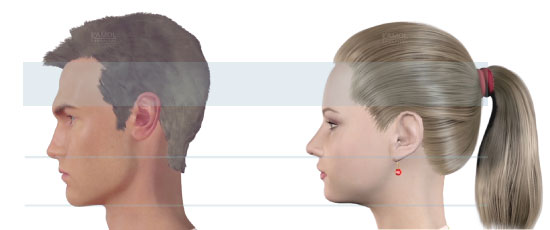FFS for short, Facial Feminization Surgery involves a collection of cosmetic procedures that alter typically male facial features, helping them to resemble the shape and size of more typical female features. It includes bone and soft tissue procedures, for example, rhinoplasty, blepharoplasty, brow lift, cheek, and lip augmentation.
In this before and after example, the patient underwent Rhinoplasty, Chin recontouring, Jaw reduction, Lip lift and Eyelid surgery (blepharoplasty). The photo is taken 4 months post-op.
The procedure is common for Male to Female Gender Reassignment patients.

The Procedure
Contents
Facial Feminization can be performed on any part of the face and the neck. Such procedures may include those of bone structures and soft tissue. Before undergoing FFS, your surgeon will require you to stop taking hormone replacement therapy 2-weeks before your scheduled surgery and another 2-weeks after surgery.

Facial Feminization Procedures are usually performed under general anesthetic due to the intrusive nature – here are some examples:
- Hairline Advancement – also known as a hairline lowering. This procedure moves your hairline forward to give you a younger look and feminize facial shape.
- Brow lift – this is considered one of the most effective procedures of FFS to feminize the upper part of the face. Men’s eyebrows are usually below their brow ridges, while women’s are above their brow ridges.
- Forehead contouring – this is often done by removing excess bone combined by reshaping to feminize your facial features. This procedure may also include bone shaving, filling, and reconstruction.
- Orbital rim contouring – eye shape is also a differentiating feature between males and females. This type of procedure is centered on the bones around the eyes. It involves the removal of the orbital ridge to bring out the eyes and make you look more feminine.
- Rhinoplasty – men’s noses are usually wider and larger than women’s noses. This type of procedure will change the shape and size of your nose to make it appear narrower, shorter and slightly concave like that of a woman.
- Cheek Augmentation– women often have fuller cheeks. Cheek augmentation can be done via fat grafting or a combination of fat grafting and cheek implants.
- Lip – such lip procedure follows after rhinoplasty. Usually, when the nose is made smaller, it tends to increase the distance between the upper lip and the nose. This procedure restores the right distance between the two.
- Chin and jaw contouring – the length of the chin can be reduced by either bone shaving or “sliding genioplasty”, wherein a section of bone/s will be removed.
- Tracheal shave – or what others know as Adam’s apple reduction. Undergoing this type of surgery will remove your thyroid cartilage to achieve a feminine looking neck.
Length of Stay in Destination
It is vital that you strictly follow all aftercare instructions as well as follow-up check-ups for your recovery. Removal of stitches (if any) will also depend on the type of procedure but tend to be about a week post-op. Note that you will not be able to travel after your surgery; you’ll need to thoroughly rest and wait for your surgeon to give you the go-ahead to travel, but expect to stay local for at least 2-weeks post-op.
Recovery Time
Expect a full rest for 2-weeks, during which you should refrain from lifting heavy objects and returning back to work for a few weeks. If you had forehead work, your surgeon will secure your eyebrows in place, so you must avoid plucking your eyebrows for a few weeks while the tissue heals. Rhinoplasty, on the other hand, is a more delicate procedure, so special care is required to avoid impacting the nose for several weeks post-surgery.
Aftercare
It is advisable that you maintain a regular check-up with your local Doctor to monitor your healing once you’ve returned home. Since FFS is a series of different procedures, aftercare will also vary on the type of surgery you have undergone.
Success Rate
Facial feminization is deemed as extremely personal. Many trans-women view it as a huge leap towards relieving their gender dysphoria, and given our technological advancements, success rates for these surgical procedures have increased significantly. A lot of trans-women have shown significant improvements in their quality of life, including their mental, physical and social well-being. On the other hand, it’s also important to be cautious about the possible risks involved with FFS, for example:
- Nerves may be damaged during scalp incision, although most people regain partial or all sensation in their scalp skin as they heal, some people might not.
- If you had lip or brow fillers, be cautious about silicone fillers. Dissolvable fillers will change the appearance of your soft tissue as you age over time.
- Infections caused by cheek and chin implants.
- Nerve damage in jaw and chin – this may actually result in permanent loss of feeling or function in the face and tongue.
Alternatives to Facial Feminization Surgery (FFS) procedures
Non-surgical treatments such as fillers and Botox or Dysport can be an alternative to facial feminization surgery. Neuromodulators are used to lessen the size of the cheeks and to sculpt the face; cheekbones can also be enhanced with the use of fillers. Fillers are used for enhancing the size of the upper and lower lip, this alternative procedure is now very popular not just to a transgender woman but as well as a cisgender woman.
For more information about Facial Feminization Surgery (FFS), watch this short video.
To check prices or to book a Facial Feminization Surgery (FFS) in Thailand or anywhere else in the world, head on over to MyMediTravel now!

